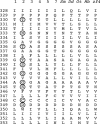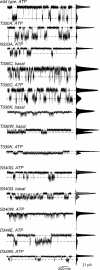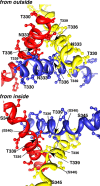Polar residues in the second transmembrane domain of the rat P2X2 receptor that affect spontaneous gating, unitary conductance, and rectification
- PMID: 19906973
- PMCID: PMC2804292
- DOI: 10.1523/JNEUROSCI.4403-09.2009
Polar residues in the second transmembrane domain of the rat P2X2 receptor that affect spontaneous gating, unitary conductance, and rectification
Abstract
Membrane ion channels activated by extracellular ATP (P2X receptors) are widely distributed in the nervous system. Their molecular architecture is fundamentally distinct from that of the nicotinic or glutamate receptor families. We have measured single-channel currents, spontaneous gating, and rectification of rat P2X2 receptor in which polar and charged residues of the second transmembrane domain (TM2) were systematically probed by mutagenesis. The results suggest that Asn(333) and Asp(349) lie respectively in external and internal vestibules. Substitutions at Asn(333), Thr(336), and Ser(340) were particularly likely to cause spontaneously active channels. At Thr(336), Thr(339), and Ser(340), the introduction of positive charge (Arg, Lys, or His, or Cys followed by treatment with 2-aminoethyl methanethiosulphonate) greatly enhanced outward currents, suggesting that side-chains of these three residues are exposed in the permeation pathway of the open channel. These functional findings are interpreted in the context of the recently reported 3.1 A crystal structure of the zebrafish P2X4.1 receptor in the closed state. They imply that the gate is formed by residues Asn(333) to Thr(339) and that channel opening involves a counter-clockwise rotation and separation of the TM2 helices.
Figures









Similar articles
-
Direct gating of ATP-activated ion channels (P2X2 receptors) by lipophilic attachment at the outer end of the second transmembrane domain.J Biol Chem. 2014 Jan 10;289(2):618-26. doi: 10.1074/jbc.M113.529099. Epub 2013 Nov 22. J Biol Chem. 2014. PMID: 24273165 Free PMC article.
-
A domain contributing to the ion channel of ATP-gated P2X2 receptors identified by the substituted cysteine accessibility method.J Neurosci. 1998 Apr 1;18(7):2350-9. doi: 10.1523/JNEUROSCI.18-07-02350.1998. J Neurosci. 1998. PMID: 9502796 Free PMC article.
-
Gated access to the pore of a P2X receptor: structural implications for closed-open transitions.J Biol Chem. 2010 Mar 26;285(13):10110-10121. doi: 10.1074/jbc.M109.089185. Epub 2010 Jan 21. J Biol Chem. 2010. PMID: 20093367 Free PMC article.
-
Molecular properties of P2X receptors.Pflugers Arch. 2006 Aug;452(5):486-500. doi: 10.1007/s00424-006-0073-6. Epub 2006 Apr 11. Pflugers Arch. 2006. PMID: 16607539 Review.
-
Cloned ligand-gated channels activated by extracellular ATP (P2X receptors).J Membr Biol. 1997 Nov 15;160(2):91-100. doi: 10.1007/s002329900298. J Membr Biol. 1997. PMID: 9354701 Review. No abstract available.
Cited by
-
Multiple roles of the extracellular vestibule amino acid residues in the function of the rat P2X4 receptor.PLoS One. 2013;8(3):e59411. doi: 10.1371/journal.pone.0059411. Epub 2013 Mar 21. PLoS One. 2013. PMID: 23555667 Free PMC article.
-
Inter- and intrasubunit interactions between transmembrane helices in the open state of P2X receptor channels.Proc Natl Acad Sci U S A. 2013 Oct 15;110(42):E4045-54. doi: 10.1073/pnas.1311071110. Epub 2013 Sep 30. Proc Natl Acad Sci U S A. 2013. PMID: 24082111 Free PMC article.
-
Activation of trimeric P2X2 receptors by fewer than three ATP molecules.Mol Pharmacol. 2012 Oct;82(4):760-6. doi: 10.1124/mol.112.080903. Epub 2012 Jul 24. Mol Pharmacol. 2012. PMID: 22828800 Free PMC article.
-
The P2X1 receptor and platelet function.Purinergic Signal. 2011 Sep;7(3):341-56. doi: 10.1007/s11302-011-9224-0. Epub 2011 Mar 22. Purinergic Signal. 2011. PMID: 21484087 Free PMC article.
-
Optical control of an ion channel gate.Proc Natl Acad Sci U S A. 2013 Dec 17;110(51):20813-8. doi: 10.1073/pnas.1318715110. Epub 2013 Dec 2. Proc Natl Acad Sci U S A. 2013. PMID: 24297890 Free PMC article.
References
-
- Brake AJ, Wagenbach MJ, Julius D. New structural motif for ligand-gated ion channels defined by an ionotropic ATP receptor. Nature. 1994;371:519–523. - PubMed
-
- Clyne JD, Brown TC, Hume RI. Expression level dependent changes in the properties of P2X2 receptors. Neuropharmacology. 2003;44:403–412. - PubMed
-
- Ding S, Sachs F. Ion permeation and block of P2X2 purinoceptors: single channel recordings. J Membr Biol. 1999b;172:215–223. - PubMed
Publication types
MeSH terms
Substances
Grants and funding
LinkOut - more resources
Full Text Sources
Molecular Biology Databases
